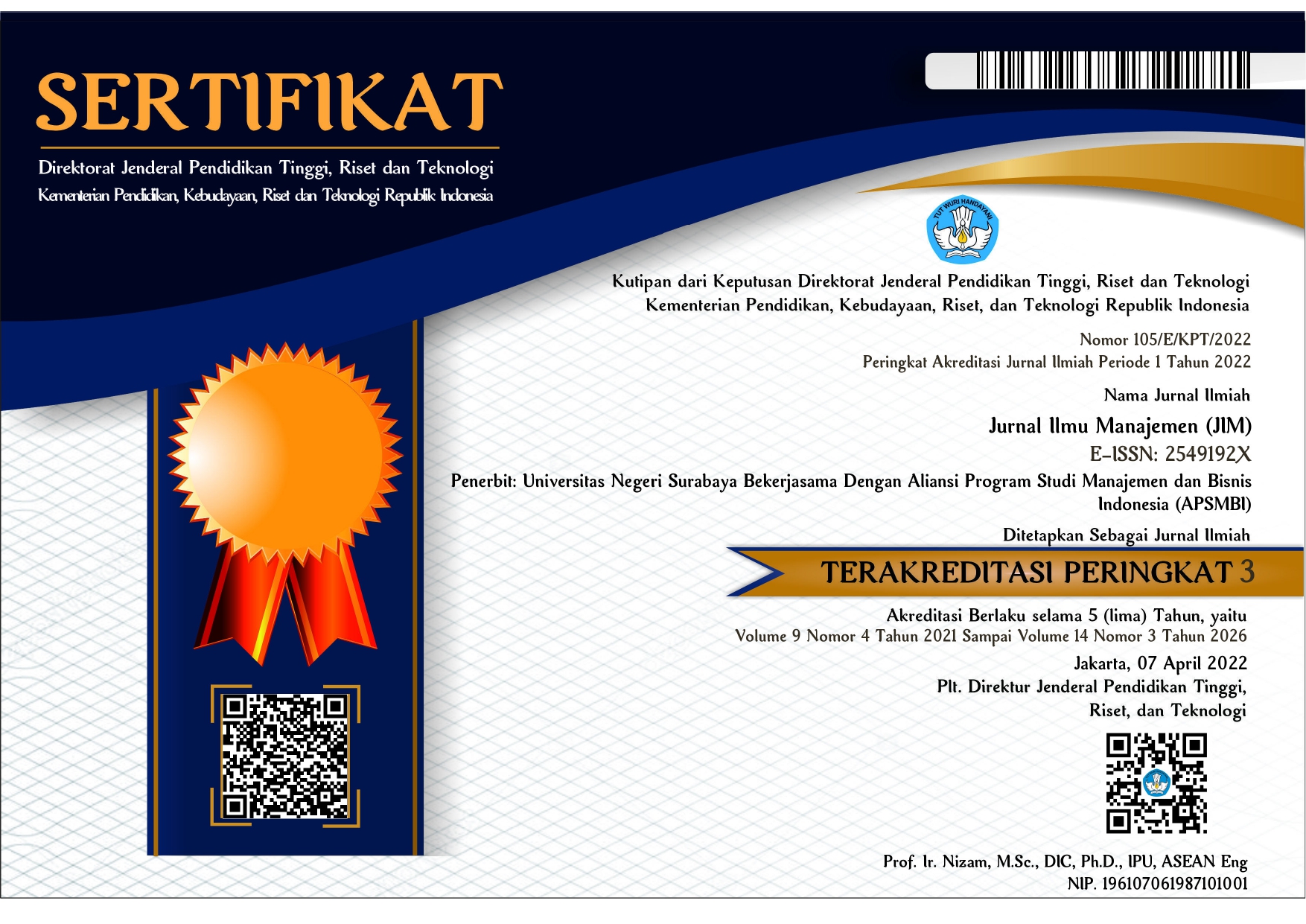Peran Moderasi Toleransi Pelanggan terhadap Pengaruh Pengalaman Pelanggan Terhadap eWOM Negatif
DOI:
https://doi.org/10.26740/jim.v10n4.p1182-1193Kata Kunci:
negative experience, positive experience, customer tolerance, negative eWOM, moderationAbstrak
Suara negatif pelanggan dapat merugikan perusahaan, Ketika suara negatif tersebut tersebar luas di media sosial. Upaya untuk mencegah pelanggan bersuara negatif antara lain dengan memenuhi janji-janji ataupun pengalaman pelanggan yang baik. Disisi lain, dalam proses pertukaran nilai antara pelanggan dengan perusahaan, ada bukti dari studi sebelumnya bahwa pelanggan dapat bertindak sebagai pembela (advocate) perusahaan atau memberikan toleransi atas ketidaksesuaian layanan perusahaan. Studi ini bertujuan mengkonfirmasi peran moderasi toleransi pelanggan pada pengaruh pengalaman positif dan pengalaman negative terhadap eWOM negative. Model diuji dengan Partial Least Square – Structural Equation Modeling (PLS-SEM) dari 209 sampel. Analisis data menemukan bahwa toleransi pelanggan dapat memoderasi pengalaman pelanggan terhadap eWOM negatif. Toleransi pelanggan atas ketidaksesuaian layanan memperkuat pengaruh pengalaman negative terhadap eWOM negatif. Sebaliknya, toleransi pelanggan dapat menurunkan pengaruh pengalaman positif terhadap eWOM negatif.
Referensi
Bachleda, C., & Berrada-Fathi, B. (2016). Is negative eWOM more influential than negative pWOM?. Journal of Service Theory and Practice, 26(1), 109.
Bell, S. J., & Eisingerich, A. B. (2007). The paradox of customer education: Customer expertise and loyalty in the financial services industry. European Journal of Marketing, 41(5-6), 466-486.
Beneke, J., Mill, J., Naidoo, K., & Wickham, B. (2015). The impact of willingness to engage in negative electronic word-of-mouth on brand attitude: a study of airline passengers in South Africa. Journal of Business and Retail Management Research, 9(2).
Bhattacharya, A., Srivastava, M., & Verma, S. (2019). Customer experience in online shopping: a structural modeling approach. Journal of Global Marketing, 32(1), 3-16.
Bilgihan, A., Kandampully, J., & Zhang, T. C. (2016). Towards a unified customer experience in online shopping environments. International Journal of Quality and Service Sciences, 8(1), 102-119.
Bleier, A., Harmeling, C. M., & Palmatier, R. W. (2019). Creating effective online customer experiences. Journal of marketing, 83(2), 98-119.
De Keyser, A., Lemon, K. N., Klaus, P., & Keiningham, T. L. (2015). A framework for understanding and managing the customer experience. Marketing Science Institute working paper series, 85(1), 15-121.
Giesler, M., & Pohlmann, M. (2003). The Social Form of Napster: Cultivating the Paradox of Consumer Emancipation. Advances in Consumer Research, 30(1).
Hair Jr, J. F., Hult, G. T. M., Ringle, C. M., & Sarstedt, M. (2021). A primer on partial least squares structural equation modeling (PLS-SEM). Sage publications.
Hair, J. F., Black, W. C., Babin, B. J., Anderson, R. E., & Tatham, R. L. (2014). Multivariate data analysis, Seventh Edition. Pearson Education Limited Harlow, Essex.
Herhausen, D., Ludwig, S., Grewal, D., Wulf, J., & Schoegel, M. (2019). Detecting, preventing, and mitigating online firestorms in brand communities. Journal of Marketing, 83(3), 1-21.
Izogo, E. E., & Jayawardhena, C. (2018). Online shopping experience in an emerging e-retailing market. Journal of Research in Interactive Marketing. 12(2). 193-214.
Izogo, E. E., Jayawardhena, C., & Karjaluoto, H. (2022). Negative eWOM and perceived credibility: a potent mix in consumer relationships. International Journal of Retail & Distribution Management, (ahead-of-print). https://doi.org/10.1108/IJRDM-01-2022-0039
Li, S. P., Lin, Y. H., & Huang, C. C. (2022). Application of the Innovative Model NIPA to Evaluate Service Satisfaction. Sustainability, 14(16), 10036.
https://doi.org/10.5176/2301-3710_JMComm18.112
Liu, B., & Li, Y. (2022). Teddy-bear effect in service recovery. Annals of Tourism Research, 94, 103400.
Low, W. S., Lee, J. D., & Lian, W. C. (2013). Can Loyal Customers Tolerate Service Failure? The Moderating Roles of Service Failure Severity and Transaction Frequency in a B2B Context. Journal of Service Science and Management, 6, 12-19.
Mahdi, M.I. 2022. Pengguna Media Sosial di Indonesia Capai 191 Juta pada 2022. (https://dataindonesia.id/digital/detail/pengguna-media-sosial-di-indonesia-capai-191-juta-pada-2022, Diakses 10 September 2022).
Mahmudan, A. 2022. Warga Indonesia Paling Sering Akses Media Sosial di Internet. (https://dataindonesia.id/digital/detail/warga-indonesia-paling-sering-akses-media-sosial-di-internet, Diakses, pada 10 September 2022).
Mersey, R.D, Malthouse, E. C., & Calder, B. J. (2010). Engagement with online media. Journal of Media Business Studies, 7(2), 39-56.
Nam, K., Baker, J., Ahmad, N., & Goo, J. (2020). Dissatisfaction, disconfirmation, and distrust: An empirical examination of value co-destruction through negative electronic word-of-mouth (eWOM). Information Systems Frontiers, 22(1), 113-130.
Parasuraman, A., Berry, L. L., & Zeithaml, V. A. (1991). Understanding customer expectations of service. Sloan management review, 32(3), 39-48.
Pentina, I., Amialchuk, A., & Taylor, D. G. (2011). Exploring effects of online shopping experiences on browser satisfaction and e-tail performance. International Journal of Retail & Distribution Management, 39(10), 742-758.
Ramayah, T., Cheah, J.-H., Chuah, F., Ting, H. and Memon, M.A. (2018), Partial Least Squares Structural Equation Modeling (PLS-SEM) Using SmartPLS 3.0: An Updated and Practical Guide to Statistical Analysis. 2nd Edition, Kuala Lumpur: Pearson.
Rose, S., Hair, N., & Clark, M. (2011). Online customer experience: A review of the business?to?consumer online purchase context. International Journal of Management Reviews, 13(1), 24-39.
Schwab, P. E. (2014). Customer Tolerance In Community Pharmacy. Electronic Theses and Dissertations. 1103, University of Mississippi, https://egrove.olemiss.edu/etd/1103
Sharma, S., Durand, R. M., & Gur-Arie, O. (1981). Identification and analysis of moderator variables. Journal of marketing research, 18(3), 291-300.
Sousa, R. (2012). The moderating effect of channel use on the quality-loyalty relationship in multi-channel e-services. International Journal of Quality & Reliability Management, 29, 1019-1037.
Tripathi, S. (2019). Impact of social media on generation Y for buying fashion apparel. Journal of Content, Community & Communication, 9(5), 105-113.
Wu, L. W. (2011). Satisfaction, inertia, and customer loyalty in the varying levels of the zone of tolerance and alternative attractiveness. Journal of Services Marketing, 25(5), 310-322.
Yap, K. B., & Sweeney, J. C. (2007). Zone?of?tolerance moderates the service quality?outcome relationship. Journal of services marketing, 21(2), 137-148.
Zeithaml, V. A., Berry, L. L., & Parasuraman, A. (1993). The nature and determinants of customer expectations of service. Journal of the academy of Marketing Science, 21(1), 1-12.
Zhang, L. L., Lam, L. W., & Chow, C. S. (2009). Segmenting the Customer Base in a CRM Program according to Customer Tolerance to Inferiority: A Moderator of the Service Failure-Customer Dissatisfaction Link. The Journal of Consumer Satisfaction, Dissatisfaction and Complaining Behavior, 22, 68-87.
Zhang, T., Omran, B. A., & Cobanoglu, C. (2017). Generation Y's positive and negative eWOM: use of social media and mobile technology. International Journal of Contemporary Hospitality Management, 29(2), 732-761.
Unduhan
Diterbitkan
Cara Mengutip
Terbitan
Bagian
Lisensi

Artikel ini berlisensi Creative Commons Attribution-NonCommercial 4.0 International License.
 Abstract views: 763
,
Abstract views: 763
, PDF Downloads: 872
PDF Downloads: 872










